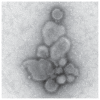Emergence of avian influenza A(H7N9) virus causing severe human illness - China, February-April 2013
- PMID: 23657113
- PMCID: PMC4605021
Emergence of avian influenza A(H7N9) virus causing severe human illness - China, February-April 2013
Abstract
On March 29, 2013, the Chinese Center for Disease Control and Prevention completed laboratory confirmation of three human infections with an avian influenza A(H7N9) virus not previously reported in humans. These infections were reported to the World Health Organization (WHO) on March 31, 2013, in accordance with International Health Regulations. The cases involved two adults in Shanghai and one in Anhui Province. All three patients had severe pneumonia, developed acute respiratory distress syndrome (ARDS), and died from their illness. The cases were not epidemiologically linked. The detection of these cases initiated a cascade of activities in China, including diagnostic test development, enhanced surveillance for new cases, and investigations to identify the source(s) of infection. No evidence of sustained human-to-human transmission has been found, and no human cases of H7N9 virus infection have been detected outside China, including the United States. This report summarizes recent findings and recommendations for preparing and responding to potential H7N9 cases in the United States. Clinicians should consider the diagnosis of avian influenza A(H7N9) virus infection in persons with acute respiratory illness and relevant exposure history and should contact their state health departments regarding specimen collection and facilitation of confirmatory testing.
Figures



References
-
- World Health Organization. Global Alert and Response (GAR): human infection with influenza A(H7N9) virus in China. Geneva, Switzerland: World Health Organization; 2013. Available at http://www.who.int/csr/don/2013_04_01/en/index.html.
-
- Gao R, Cao B, Hu Y, et al. Human infection with a novel avian-origin influenza A (H7N9) virus. N Engl J Med. 2013 April 11; [Epub ahead of print] - PubMed
-
- Li Q, Zhou L, Zhou M, et al. Preliminary report: epidemiology of the avian influenza A (H7N9) outbreak in China. N Engl J Med. 2013 April 24; [Epub ahead of print]
-
- CDC. CDC health advisory: human infections with novel influenza A (H7N9) viruses. Atlanta, GA: US Department of Health and Human Services, CDC, Health Alert Network; 2013. Available at http://emergency.cdc.gov/han/han00344.asp.
MeSH terms
LinkOut - more resources
Full Text Sources
Medical
Miscellaneous

